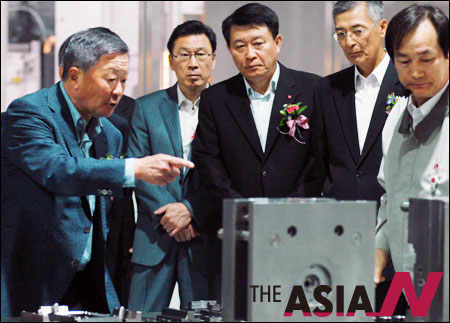LG seeks corporate overhaul for growth

After laboring through a dismal 2011, things appear to be improving at LG Group. Chairman Koo Bon-moo has stressed that rebuilding efforts are ongoing as he pushes another round of business-lineup adjustments and an organizational shakeup.
Earnings and profits at LG’s key business units, LG Electronics, LG Display, LG Innotek and LG Chem, have been rising in recent months, suggesting the group is becoming resurgent in its main markets of consumer electronics, mobile phones and industrial components. However, Koo has no intention to sit on his laurels, company sources say.
“There is stronger demand from the top that every business must improve efficiency and react faster to the changing needs of customers. Changing of habits, implementation of new ideas and creating synergy between different businesses are key focuses for the group,’’ said LG Group spokesman Ahn Young-hoon.
“In a recent meeting with senior executives at the group’s headquarters in Yeouido, Koo ordered the key group subsidiaries to review their annual business plans from square one and come up with new ones that reflect the impact of the heightened economic uncertainty. He demanded specific and practical plans, but also promised the companies more autonomy in business decisions, and freedom in bulking up their research and development (R&D) staff without the pressure of delivering immediate results.’’
Amid worsening global conditions, highlighted by European debt troubles, the faltering recovery in the United States, and a slowing China, companies around the world are shaving their expectations, LG still believes it could meet its annual targets in revenue, profit and investment through some timely adjustments.
The company says it’s better positioned to weather the downturn than in past years, when the lack of product diversity and quality and poor supply-chain management impacted on its business progress.
LG is eyeing 150 trillion won (about $132 billion) in revenue for the year, including 57.6 trillion won from consumer electronics and mobile phones, 28 trillion won from displays and 24.55 trillion won from chemicals and rechargeable batteries.
“Koo acknowledges the difficult environment but insists that we still have to do what we have to do. The group will spend around 16.4 trillion won on expanding facilities and developing new businesses as we had previously planned. Since the start of the year, Koo has been stressing the need to improve chemistry and cohesion between different businesses and improve R&D,’’ Ahn said.
In a message to employees earlier this year, Koo called for closer collaboration between LG Electronics, LG Chem and other parts makers as they can help each other to strengthen their positions in expanding markets such as organic light emitting diode (OLED) televisions and mobile Internet devices.
“If you want to become a market-leading company, then you have to introduce market-leading products with great quality and innovation faster than the rivals. This requires us to change completely,’’ Koo wrote in the e-mailed statement.
Koo has been encouraged by LG’s improving shares in hot technology segments such as three 3D televisions.
The collaboration between LG Electronics and LG Display on “film-patterned’’ 3D technology, which they believe allows companies to build cheaper 3D televisions with sharper and steadier images, is beginning to pay off. The technology has been adopted by major brands Sony and Panasonic.
Meanwhile, LG is also becoming bolder in the merger and acquisition (M&A) market. It paid $45 million to acquire a 51 percent stake in Rolls-Royce Fuel Cell Systems. LG is developing a solid oxide fuel cell system designed to provide megawatt-scale electricity for industrial and commercial customers as well as electric utilities. The fuel cells would run on natural gas. <The Korea Times/Kim Yoo-chul>




